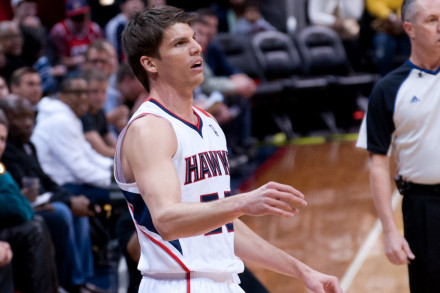An Answer to the Hawks’ Success
If I told you at the beginning of the season that the Atlanta Hawks would have a commanding lead in the Eastern Conference going into the All-Star game, you would’ve thought I was crazy.
Well, it’s true.
The NBA All-Star Weekend is upon us and the Hawks have a 42-10 record and are seven games ahead of the Toronto Raptors, who are second in the Eastern Conference.
What makes the Hawks inherently unique is that they don’t have a prototypical superstar. Instead they have a well-balanced and underrated team. The Hawks have been able through the years to assemble a number of high-quality players.
One of these players is Kyle Korver. At age 33, Korver is having arguably the best year of his career and is one of the primary reasons why the Hawks find themselves in first place.
Korver was the 22nd pick of the second round in the 2003 NBA draft (51st overall), out of Creighton University. Korver primarily plays shooting guard and small forward.
He’s mostly been a journeyman throughout his career, playing for the Philadelphia 76ers, the Utah Jazz, the Chicago Bulls and now the Atlanta Hawks. This is Korver’s 11th year in the league and he’s averaging 12.9 points per game.
That may not seem very impressive on the outset but it’s how Korver accumulates his 12.9 points per game that makes him an extremely valuable player. Korver is leading the league in three-point percentage at 53.1%.
He also led the league in three-point percentage in the 2009-2010 season and the 2013-2014 season. Korver, however, has always been known as an extremely good three-point shooter. It’s the reason he’s been in the league for the last 11 years.
Why Korver has remained an underrated and underappreciated commodity is that people don’t realize just how efficient he’s been. During this campaign, Korver has been leading the league in TS% (True Shooting Percentage) at 73.9%
TS% is an advanced stat that takes into account two-point field goals, three-point field goals, and free throws. This is a more accurate way of measuring one’s shooting ability because it takes into account all aspects of shooting. The TS% is also a statistical category that is predominantly dominated by the big men.
Korver, for example, is the only player in the top 10 of the TS% rankings that is not either a power forward or a centre. He’s also not doing this on a small amount of minutes.
This year, Korver is averaging 35.7 minutes per game and just to put things into perspective, Steph Curry (33.2) and Kevin Durant (33.5) average the same amount of minutes per game.
What makes Korver’s 2014 season even more impressive is that he doesn’t need to have the ball in his hands to be effective.
Korver’s USG (Usage Percentage) is at 14.2. USG is the estimated percentage of plays a player will take up, when he is on the floor. The lesser, the better. Why? Because the fewer amount of plays a player will take up, the more amounts of plays can be distributed throughout the rest of the team, essentially meaning that since Korver takes up very few amounts of plays, the more plays can therefore be distributed to Paul Millsap and Jeff Teague.
This is obviously not to suggest that Korver is the best player on the Hawks or that he is the primary reason for their success. It is rather to provide one of many possible answers for the Hawks’ success and to bring attention to one of the more underappreciated players in the NBA.


_600_832_s.png)

2__600_375_90_s_c1.jpg)
webresize__600_375_90_s_c1.jpg)
2webedit__600_375_90_s_c1.jpg)
1_600_375_90_s_c1.jpg)